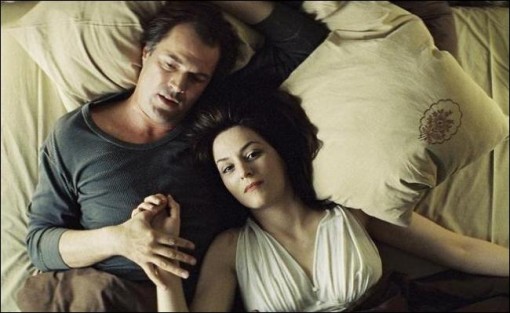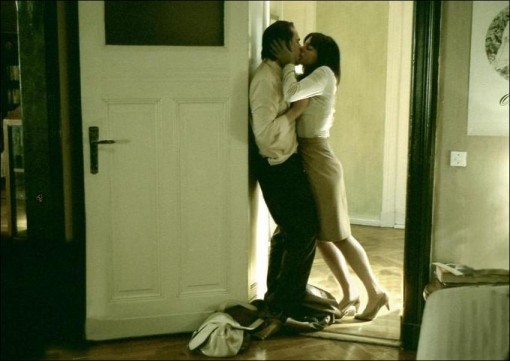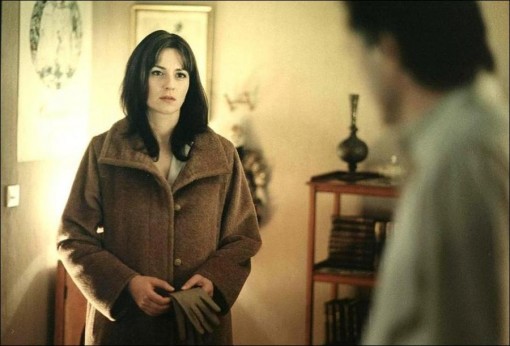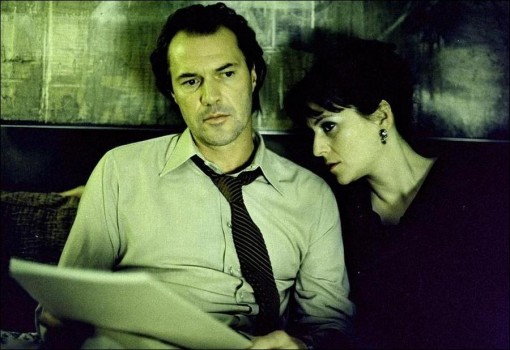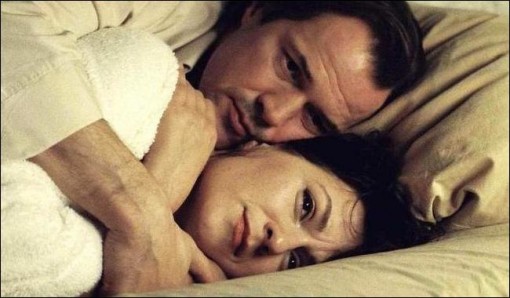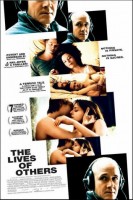Tagline: Nothing is private. Nothing is sacred.
East Berlin, November 1984. Five years before its downfall, the former East-German government ensured its claim to power with a ruthless system of control and surveillance. Party-loyalist Captain Gerd Wiesler hopes to boost his career when given the job of collecting evidence against the playwright Georg Dreyman and his girlfriend, the celebrated theater actress Christa-Maria Sieland.
After all, the “operation” is backed by the highest political circles. What he didn’t anticipate, however, was that submerging oneself into the world of the target also changes the surveillance agent. The immersion in the lives of others–in love, literature, free thinking and speech–makes Wiesler acutely aware of the meagerness of his own existence and opens to him a completely new way of life which he has ever more trouble resisting. But the system, once started, cannot be stopped. A dangerous game has begun.
Plot Description
A man who has devoted his life to ferreting out “dangerous” characters is thrown into a quandary when he investigates a man who poses no threat in this drama, the first feature from German filmmaker Florian Henckel von Donnersmarck.
It’s 1984, and Capt. Gerd Wiesler (Ulrich Muehe) is an agent of the Stasi, the East German Secret Police. Weisler carefully and dispassionately investigates people who might be deemed some sort of threat to the state, and after attending a performance of a new drama by celebrated East German playwright Georg Dreyman (Sebastian Koch), Weisler begins to wonder if this renowned patriot is all that he seems to be. With the help of his superiors Hempf (Thomas Thieme) and Lt. Col. Grubitz (Ulrich Takur), Weisler plants listening devices in Dreyman’s apartment and begins shadowing the writer.
As Weisler monitors Dreyman’s daily life, he discovers the writer is one of the few East Germans who genuinely believes in his leaders and Weisler becomes deeply infatuated with Christa-Maria (Martina Gedeck), Dreyman’s girlfriend. A certain degree of voyeuristic pleasure keeps Weisler on the case, but with time Grubitz and Hempf insist Weisler find something subversive they can hang on Dreyman to justify their investigation. A major box-office success in Germany, Das Leben der Anderen (aka The Lives of Others) received its North American premiere at the 2006 Toronto Film Festival.
At once a political thriller and human drama, The Lives of Others begins in East Berlin in 1984, five years before Glasnost and the fall of the Berlin Wall and ultimately takes us to 1991, in what is now the reunited Germany. The Lives of Others traces the gradual disillusionment of Captain Gerd Wiesler (Ulrich Muhe, best known for his lead roles in Michael Haneke’s Funny Games and as Dr. Mengele in Costa-Gavras’ Amen), a highly skilled officer who works for the Stasi, East Germany’s all-powerful secret police. His mission is to spy on a celebrated writer and actress couple, Georg Dreyman (Sebastian Koch) and Christa-Maria Sieland (Martina Gedeck).
Five years before its downfall, the former East- German government (known as the GDR, German Democratic Republic) ensures its claim to power with a ruthless system of control and surveillance via the Stasi, a vast network of informers that at one time numbered 200,000 out of a population of 17 million. Their goal is to know everything about “the lives of others.”
Devoted Stasi officer and expert interrogator Wiesler is given the job of collecting evidence against the famous playwright Georg Dreyman. The job begins after Lieutenant Colonel Anton Grubitz (Ulrich Tukur), a former classmate of Wiesler’s who now heads the Culture Department at the State Security, invites Wiesler to accompany him to the premiere of the new play by Dreyman, also attended by Minister Bruno Hempf (Thomas Thieme).
Minister Hempf tells Grubitz that he has doubts about the successful playwright’s loyalty to the SED, the ruling Socialist Unity Party, and implies that he would approve of a full-scale surveillance operation. Grubitz, eager to boost his own political future, entrusts the monitoring, or “Operative Procedure,” to Wiesler, who promises to oversee the case personally. Wiesler is also convinced that Dreyman cannot possibly be as loyal to the Party as has always been assumed.
However, Hempf’s distrust of Dreyman is not politically motivated. Hempf cannot take his eyes off the attractive lead actress Christa-Maria Sieland, Dreyman’s girlfriend. While Dreyman is away from their home, his apartment is systematically bugged. A neighbor who notices the operation is forced to keep silent by a personal threat. Wiesler sets up his surveillance headquarters in the attic of Dreyman’s apartment building, thus beginning Wiesler’s cold and calculating observation of the lives of the playwright and his girlfriend.
At first Weisler’s observations show that, unlike most of his artistic peers, Dreyman does not display any outwardly disdain for the GDR. Dreyman’s position slowly changes however, as he discovers that Christa-Maria has been pressured into a sexual relationship with Minister Hempf. When his close friend, theater director Albert Jerska (Volkmar Kleinert) is driven to suicide after seven years of unofficial “blacklisting” by the government, Dreyman can no longer remain silent about the GDR. Now determined to alert the outside world about the conditions of life under the GDR, he begins a plot to place an article with the famous West German publication Der Spiegel, exposing the GDR’s policy of covering up the high suicide rates under the regime.
Wiesler, who has been monitoring all of Dreyman’s activities, finally has the proof he needs to destroy his subject and to serve the GDR by foiling Dreyman’s plot. But Wiesler’s unemotional façade is showing signs of erosion. While he observes the day-to-day life of Dreyman and Christa-Maria, he begins to be drawn into their world, which puts his own position as an impartial agent of the GDR into question. His immersion in “the lives of others,” in love, literature and freethinking, also makes Wiesler acutely aware of the shortfalls of his own existence.
When the anti-GDR article is published, the regime is thoroughly embarrassed and Grubitz is ordered to discover the identity of the article’s author. Dreyman is one of the prime suspects, but Grubitz cannot believe that the trustworthy Wiesler would have failed to discover the plot.
At the same time, Hempf’s discovery of Christa-Maria’s drug addiction forces her to expose her lover as the author of the Der Spiegel article, but a search of Dreyman’s apartment does not yield any incriminating evidence. Convinced that Weisler knows more than he is revealing, Grubitz summons him to interrogate Christa-Maria in order to find the one item linking Dreyman to the Der Spiegel article. Wiesler, who has known all along about the source of the article and purposely failed to disclose the information to his superiors, must now decide where his allegiances lie. If he does not extract the information from Christa-Maria, his life and his career as an elite Stasi officer will undoubtedly be over. If he succeeds, Dreyman’s fate will be sealed.
In 1991, two years following the fall of the Berlin Wall, Dreyman is in for a rude awakening when he runs into ex-minister Hempf and learns that he had been the subject of a Stasi surveillance. Immediately afterward, he finds the cables and microphones secretly installed years earlier behind the wallpaper in his apartment. In disbelief, he sets out to research and discovers the different reality of his past, which not only has a profound impact on his life but also surprises him with shocking revelations.
Director’s Statement
German movies produced after the reunification generally, and strangely, depict the GDR (the German Democratic Republic or former East Germany) as funny or moving. Both my parents come from the East, so as a child, I was often in East Germany to visit friends and relatives. A cousin of my father’s had been named chief of protocol of Erich Honecker, the East German head of state and boss of the ruling S.E.D party (Sozialistische Einheitspartei Deutschlands, the Socialist Unity Party of Germany).
Other people we knew had very normal jobs, yet one could see the fear in all of them, right up to the end of the regime. Fear of the Stasi (The State Security), fear of the 100,000 highly trained employees whose sights were trained on one thing: “The Lives Of Others”: the lives of those who thought differently, who were too free spirited and above all, the artists and people working in the arts.
Every aspect of life was recorded. There was no private sphere and nothing was sacred, not even one’s closest family members. I met Stasi victims who had been jailed and harassed in Hohenschonhausen (where the central detention center of the Stasi was located). I asked “unofficial agents” about their activities and I talked to documentary filmmakers who had worked on these topics.
In the film, each character asks questions that we confront every day: how do we deal with power and ideology? Do we follow our principles or our feelings? More than anything else, The Lives of Others is a human drama about the ability of human beings to do the right thing, no matter how far they have gone down the wrong path. — Florian Henckel von Donnersmarck
GDR (German Democratic Republic) 1949-1989
Background Information
The rule of the Socialist Unity Party of Germany (SED – Sozialistische Einheitspartei Deutschlands) was based on a worldview informed by Marxist-Leninism and molded by class warfare. The Socialist Unity Party had expectations from “its people,” which it laid down in the form of programs, plans, directives and clear restrictions, which resulted, for example, in political criminal law.
The conceptual eradication of specific human individuality allowed the Ministry for State Security (Ministerium für Staatssicherheit, MfS) to categorize the “others,” whom it interrogated and spied on, in order to transform them into objects of its hatred. The abbreviation “Stasi” was the SED dictatorship’s designated secret apparatus of repression.
To be arrested was seen as proof that one was an enemy or part of a hostile, negative “element.” The Stasi understood its party program as an active and threatening involvement in the “lives of others,” in order to change them radically when they no longer corresponded to the party’s expectations.
The central detention center of the Stasi was in Berlin Hohenschönhausen and young interrogators were trained at the Stasi College in Potsdam-Eiche. The term “Operative Procedure” (Operativer Vorgang, OV) was used by the Stasi to designate the highest level of monitoring of suspected individuals. (In The Lives of Others, the playwright Georg Dreyman is the subject of an “Operative Procedure.”)
One typical “offense against the system,” punishable by two years of imprisonment, was “illegal border crossing”. Even planning and trying to “flee the republic” was punishable. The fortification of the inner-German borders and the Berlin Wall gave rise to escape agents from the West and whoever contributed to taking someone “abroad” was threatened with a sentence of up to eight years.
In the GDR, a nation under surveillance, there were about 13,000 of the 91,000 employees of the Stasi regulating an army of about 170,000 Unofficial Employees (Inoffizielle Mitarbeiter, IM) in order to realize the SED’s delusional project of the total surveillance of an entire society.
Manfred Wilke (Professor Manfred Wilke is the head of the Lankwitz Division of the Research Committee SED Regime at the Freie Universität Berlin. Wilke was a historical adviser forThe Lives of Others).
Interview with Director Florian Henckel von Donnersmarck
What was the genesis of the project and is it based on personal experiences?
Over the years, there were two things that led me to make the film. First were many childhood memories of my visits to East Berlin and the GDR. As a boy of eight, nine or ten, I found it interesting and exciting to feel the fear of adults. My parents were afraid when they crossed the border: they were both born in the East and thus were more closely controlled by the police. And our friends from East Germany were afraid when other people saw that they were speaking with us, Germans from the West. Without these early experiences I would have had trouble finding the right approach.
There was an image I saw in film school that I was never able to forget: the close-medium shot of a man sitting in a bleak room, wearing headphones and listening to beautiful music even though he did not want to hear it. This man pursued me in my dreams and evolved over the years into Captain Gerd Wiesler.
You conducted intensive research for this film – how and where?
My research took four years. I went to many places where you can still feel the spirit of the past. A key location is the Hohenschönhausen Memorial or the former Ministry for State Security in Normannenstrasse. That’s where the former Stasi headquarters are located. Today it is called the Research Agency and Memorial as well as the Birthler Bureau and its archives.
Places can store emotions and these visits often gave me more than the many books that I read, and the documentaries that I watched. What was decisive however, were the conversations with eyewitnesses, from Stasi Lieutenant Colonel Wolfgang Schmidt, the head of the Evaluation and Control Group of the “HA XX,” (code names for the Stasi spies) to Stasi prostitutes and people who spent up to two years in Stasi detention centers.
I was advised on historical matters by a number of experts, including Prof. Manfred Wilke, head of the Research Committee on the SED (Sozialistische Einheitspartei Deutschlands: Socialist Unity Party of Germany) Regime; Jörg Drieselmann, head of the Research Agency and Memorial in Normannenstrasse, and Stasi colonel Wolfgang Schmidt.
I tried to get as many perspectives as possible and heard many contradictory stories – but in the end, I felt I had obtained a very definite feel for the era and its problems. The last and most important element was provided by my work with the actors and crewmembers. Most of them came from the East and brought with them many personal experiences and viewpoints.
For instance, Ulrich Muhe who plays Captain Gerd Wiesler found out after the Wall came down that he has been a Stasi victim, spied on in the 1980s by his then wife. She had met regularly with the Stasi and spied on Muhe, one of Germany’s best-known actors, in addition to other actors. She has denied the claims and said the Stasi invented the file on her. She has also won an injunction to halt publication of the book detailing the claims. The power of denial is amazing. There’s a 254 pages file detailing her involvement with the Stasi for which she was an informer for 10 years!
Thomas Thieme, who plays the minister, left East Germany in the 1980s, but his life was made hell once he applied to leave the country. Volkmar Kleinert who plays director Albert Jerska was asked by the Stasi to become an informer. He told me that the Stasi really made it sound as if he did not cooperate, he would have no career. When they called him on the appointed hour to find out his decision, Kleinert shouted “No!” into the phone and hung up. They never bothered him again and he ended up becoming a very prominent actor.
Another actor, Charly Hubner, invited his father to the premiere of the film. He was photographed with him and that photo appeared in the press. Because of that, many people identified the father as a Stasi officer. His father felt almost liberated by it after 20 years of keeping it secret. Now he is going from door to door apologizing to people he damaged through his activities. And for others, my research and the shooting were the occasion to speak about these things for the very first time, fourteen years after reunification. Some wounds truly take a very long time to heal.
Were there specific models for characters or events?
The characters were compiled from many different real-life figures, and many people will certainly be able to identify with one or the other character. But the film is not a “roman à clef” or a “film à clef.” Certain details about characters and events were deliberately left out. For example, Hempf is a minister without a portfolio. To me, what was important was not to lose myself in historical details but to tell a story about real people with an emotional viewpoint.
Can you talk about shooting in original former GDR locations?
Part of the quest for authenticity went into shooting in as many original locations as possible. Among the venues we chose were the former Stasi headquarters in Normannenstrasse – a feared address during the years of the SED regime. The scenes with Ulrich Tukur (as Lieutenant Colonel Anton Grubitz) were shot there. His office was directly next to that of Stasi boss Mielke. The finish of the GDR furniture in these offices had even been preserved. With their typical wood paneling, these offices have a unique look, which can be clearly assigned to a particular time and style – a situation that is both exciting and oppressive.
The production was also the first and is, to this day, the only feature film allowed to shoot in the original file-card archives of the former Stasi headquarters with the special authorization of Marianne Birthler, (the Head of the Federal Authority for Documents of the State Security Service of the Former GDR.)
The archive was a gigantic mechanical filing system, which has been restructured and digitalized since the shooting was completed. The data are preserved, but the location of the files and documents no longer exists in the form shown in the film. Although the film relates to events that took place only fifteen years ago, much has changed since then. One of the challenges was the painting over of graffiti, which is nowadays found everywhere. No sooner had the graffiti been painted over than they reappeared the following morning.
What was your approach with respect to sound, set design and color schemes?
To capture the atmosphere of East Berlin, we did not record in digital but in analog in order to convey a sense of “reduced calm.” Set designer Silke Buhr and I had a very definite idea about the color scheme. The GDR had its own world of colors and forms. The cars and fabrics were pale and desaturated. We proceeded through reduction. Since there was more green than blue in the GDR, we completely omitted blue.
There was also more orange than red, so we eliminated red. We consistently used certain shades of brown, beige, orange, green and gray to try and be as authentic as possible to what life under the GDR looked like. Emptiness is an aesthetically neutral condition. The streets of East Berlin are filmed almost empty, exactly as they were during those years. The local Kneipe, or pub, is almost empty; the canteen for the Stasi employees is Spartan. Wiesler’s apartment, a “plattenbau” (or high-rise apartment the Communists built during the 70s) is devoid of any sense of being a home.
Wiesler’s world actually starts to open when he begins spying on the actors who live in a charming Altbau, a typical old Berlin apartment with big rooms, high ceilings and creaky wooden floors. When he is perched above their apartment, using the attic as his listening post, I wanted to conveythat his worldview was challenged. We did not want an overload of “GDR props.” For me, the set design has to deliver the perfect background for the emotions of the actors – no more, but also no less. I don’t want the viewer to start thinking about individual props instead of emotionally connecting with the characters.
How did you manage to recruit Oscar winner Gabriel Yared to write the film score?
It took quite a bit of time, but I don’t take no for an answer! I had written my final film school project on “The Talented Mr. Ripley” (with a score written by Yared) and always had the feeling that I had only come to understand the film through the music. I kept writing to Gabriel until I was finally able to meet him. He is a native French speaker and we gave him a translation of the script at an early phase. We had several conversations in Paris and Londonand he got really interested.
Yared’s work method involves writing music for a film during the script phase. We got together three times in London in order to work on this together. For instance, he composed the “Sonata for a Good Man,” that Dreyman plays, before we started to shoot. Interestingly, Sebastian Koch said that he only truly understood how to play Dreyman after playing this piece, which shows that Gabriel’s method makes sense! The music was recorded in Prague with the Prague Symphony Orchestra, which is considered one of the best in the world.
Cast Biographies
Martina Gedeck (Christa-Maria Sieland)
Award-winning Martina Gedeck is one of Germany’s most renowned actresses. Born in Munich, she studied at Berlin’s Free University where she majored in drama and went on to develop a stage career all over Germany. In the early 1990s, Gedeck became a regular fixture in the films of the younger German generation such as “Maybe, Maybe Not”, “Talk of the Town”, “Life Is All You Get” and “Rossini”, with the latter two earning her Lola Awards, (Germany’s equivalent of the Academy Awards) for Best Supporting Actress.
Gedeck made her international breakthrough with the hit film “Mostly Martha,” for which she earned a German Film Award for Best Actress in 2002. Four years later she was nominated again for the German Film Award as Best Actress in a Supporting Role for the Berlin International Film Festival competition film “The Elementary Particles”.
Since The Lives of Others, Gedeck has worked on several European films including French director Francis Girod’s “A Perfect Friend” and her next projects include Academy Award winner Marleen Gorris’ new film, “Within the Whirlwind” in which she will play Eugenia Ginzburg, a Russian writer sent to a gulag in 1937. In addition to her acting duties, Gedeck has served on the 2004 Berlin International Film Festival jury.
Ulrich Mühe (Gerd Wiesler)
One of Germany’s most acclaimed actors, Ulrich Mühe was born in Grimma in the former East in 1953. He trained as a construction worker before studying acting in Leipzig in 1975. He went on to join the ensemble of the Deutsches Theater, where he established his reputation as a prominent stage actor. Mühe appeared in a number of GDR films and TV productions before making his film debut as the lead in Bernhard Wicki’s “Spider’s Web” in 1989.
After the German reunification Mühe played leading roles in “Benny’s Video”, “Funny Games” and “The Castle” directed by acclaimed director Michael Haneke. Costa-Gavras cast him as the infamous concentration camp Doctor Mengele in “Amen”, in a performance that drew him much praise. His role as Captain Gerd Wiesler in The Lives of Others earned Mühe a Lola Award, (Germany’s equivalent of the Academy Award) for Best Actor.
Sebastian Koch (Georg Dreyman)
Born in Karlsruhe, Germany in 1962, Koch studied at the renowned Otto Falckenberg School in Munich and took his first steps as an actor in theater before making his film and TV debut. He has gone on to win several awards for his television roles and in 2002 and became the only actor to win two German Emmy Awards for different roles in the same year.
In 2004, Koch portrayed the Nazi architect Albert Speer in Heinrich Breloer’s three-part docudrama “Speer and Hitler: The Devil’s Architect”, which aired on the BBC. His recent film credits include “The Tunnel” directed by Roland Suso Richter, based on a true story of a group of East Berliners escaping to the west in 1961 and art house hit “Amen” directed by Costa-Gavras with his The Lives of Others co-star Ulrich Muhe. His upcoming projects include Paul Verhoeven’s WWII thriller “Blackbook”.
Ulrich Tukur (Lieutenant Anton Grubitz)
Ulrich Tukur was born in Viernheim in 1957 and worked as an accordion player and singer before taking up acting. In 1982 he made his film debut in Michael Verhoeven’s “The White Rose”. Besides “The White Rose,” Tukur is known for his roles in such acclaimed historical films as “Stammheim” (in which he played the terrorist Andreas Baader of the Baader-Meinhof gang,) “The Comedian Harmonists,” “Bonhoeffer – Agent of Grace,” Istvan Szabo’s “Taking Sides” opposite Harvey Keitel and “Amen” directed by Costa-Gavras in 2002. He also appeared in Steven Soderbergh’s “Solaris” opposite George Clooney and Natascha McElhone.
Tukur’s upcoming projects include Academy Award winner Marleen Gorris’ new film, “Within the Whirlwind” with his The Lives of Others co-star Martina Gedeck. In addition, Tukur will be seen as Robert Schumann in “Clara,” the new film by acclaimed director Helma Sanders-Brahms, about the lives of 19th-century composers Clara and Robert Schumann opposite Isabelle Huppert. Tukur won a Lola Award, (Germany’s equivalent of the Academy Award) for Best Actor for his role as Lieutenant Anton Grubitz in THE The Lives of Others..
Crew Biographies
Florian Henckel von Donnersmarck (Director, Screenplay)
Florian Henckel von Donnersmarck was born in Cologne in 1973 and grew up in New York, Berlin, Frankfurt and Brussels. Following his Russian Studies at the National IS Institute in Leningrad (now St. Petersburg), he enrolled at Oxford University to study political science, philosophy and economics. He then decided to embark on a film career and worked as a PA on Richard Attenborough’s “Love and War.”
He was admitted to the prestigious directing class at the Academy of Film and Television in Munich where he wrote and directed several award-winning short films. The Lives of Others is his feature directorial debut, for which he won three Lola Awards (Germany’s equivalent of the Academy Awards) for Best Film, Best Director and Best Screenplay,
Hagen Bogdanski (Cinematography)
Award-winning Hagen Bogdanski studied art and photography in Berlin where he was born in 1965. After completing his studies, he worked as an assistant cameraman and quickly became a prominent director of photography in the German film and television industry. Bogdanski has won the Kodak Advancement Prize twice and, for his work on The Lives of Others, was the recipient of the Lola Award (Germany’s equivalent of the Academy Awards) for Best Cinematography.
Gabriel Yared (Music)
Acclaimed composer and Academy Award winner Yared was born in Beirut in 1949. After making his film debut in Jean-Luc Godard’s “Every Man For Himself,” Yared went on to write over eighty scores, becoming one the film industry’s most sought after composers. He has collaborated with Anthony Minghella on “The English Patient,” “The Talented Mr. Ripley” and “Cold Mountain” and written the scores for Robert Altman’s “Vincent and Theo,” Jean-Paul Rappeneau’s “Bon Voyage” and Jean-Jacques Beineix’ “Betty Blue.”
A multiple award-winner, Yared won an Academy Award and a Golden Globe for Best Score for “The English Patient,” the British Academy Award (BAFTA) for “Cold Mountain” as well as the César (Frane’s equivalent of the Academy Award) for Jean-Jacques Annaud’s “L’Amant.” He was nominated twice for an Academy Award and a Golden Globe for “Cold Mountain” and “The Talented Mr. Ripley.” Most recently Yared has worked with Anthony Minghella again on the director’s latest film, “Breaking and Entering.”
Production notes provided by Sony Pictures Classics.
The Lives of Others
Starring: Martina Gedeck, Ulrich Muehe, Sebastian Koch, Ulrich Tukur, Thomas Thieme, Volkmar Kleinert
Directed by: Florian Henckel von Donnersmarck
Screenplay by: Florian Henckel von Donnersmarck
Release Date: February 9, 2007
MPAA Rating: R for some sexuality / nudity.
Studio: Sony Pictures Classics
Box Office Totals
Domestic: $11,286,112 (15.0%)
Foreign: $64,018,508 (85.0%)
Total: $75,304,620 (Worldwide)
